The researchers found a cyclic hydrocarbon benzene in the protoplanetary disk, as well as a number of simpler molecules. The MIRI instrument, located on board the James Webb Space Observatory, helped them to do this.

Organic molecules in the protoplanetary disk
A group of scientists from the Netherlands Research School of Astronomy and a number of scientific institutions from other countries were able to find organic substances in the protoplanetary disk surrounding the young star J160532. It is located at a distance of about 500 light years from us in the direction of the Scorpio constellation. The mass of this object is approximately one-tenth of the Sun. The process of formation of large bodies has already begun in the gas-dust disk around it, but the planets have not formed yet.
Previously, astronomers could not study the chemical composition of such hot protoplanetary clouds, but now they have a medium-range infrared MIRI instrument. It allows scientists to perform spectroscopic studies even in such difficult conditions.
“This is exactly the kind of science the MIRI spectrometer was designed for. The spectra contain a wealth of data that tell us something about the chemical and physical composition of planet-forming disks,” said Ewine van Dishoeck (Leiden University), who was involved in the development of James Webb telescope and the MIRI instrument from the very beginning.
Benzene and other compounds
The main compound found in the protoplanetary disk J160532 is benzene. Its chemical formula is C₆H₆. In addition, there are several simple organic molecules, mainly acetylene С₂Н₂ and diacetylene С₄Н₂. At the same time, there is extremely little water and carbon dioxide in the disk. Usually there are a lot of these oxygen-rich compounds in protoplanetary disks, but not in this case.
The researchers suspect that benzene and diacetylene are released in the disk after the destruction of carbon-rich dust grains by an active young star. Those that remain consist of silicates with a relatively low carbon content. Later, the low-carbon grains stick together into larger chunks. Eventually they become rocky planets like Earth. This scenario may explain why our house is so carbon poor.
All this is just the beginning of work on the spectroscopic study of protoplanetary disks. Another 20 of them are planned to study during this year and another 30 are waiting for their turn in the future. At the same time, scientists believe that they will be able to find other organic molecules in them.
The survey will allow scientists to study protoplanetary disks that form around very different stars, from the smallest to those that are 2-3 times larger than the Sun. They want to understand how different they are and how these differencies affect the formation of planets.
According to phys.org
Follow us on Twitter to get the most interesting space news in time
https://twitter.com/ust_magazine
